UNDERWATER EXTENSION OF THE SPINE. HERNIATED DISC.
Differential diagnosis of herniated lumbar intervertebral disc
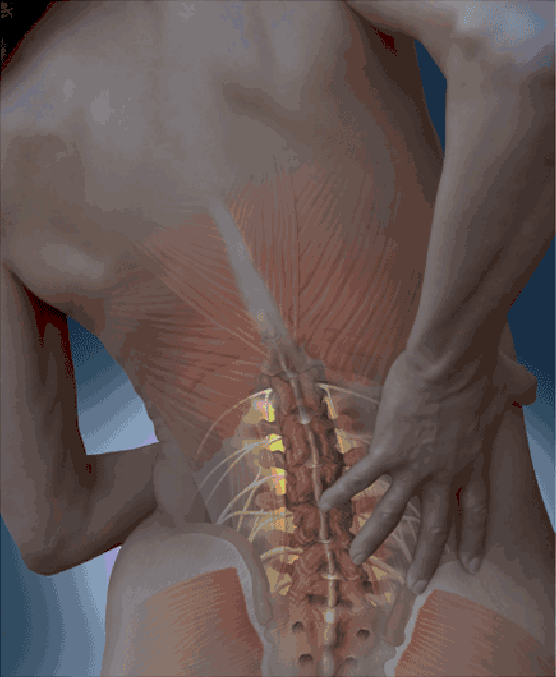
- - Injuries of the spine
- - Spinal canal stenosis
- - Spondylolysis
- - Spondylolisthesis
- - Spondylarthritis
- - Epidural abscess
- - Epidural hematoma
- - Gynaecological pathology
- - Patologie ginecologică
- - Tumors
- - Spinal vascular aneurysm
Example of MRI of the patient with herniated intervertebral disc.
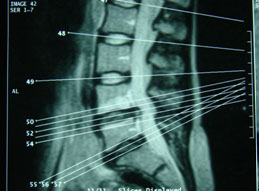

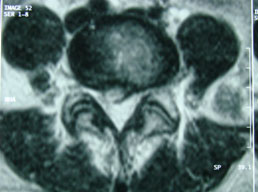
Indications for underwater spine extension
- Spine spondylosis with radicular, neurodystrophic, musculotonic symptoms;
- Herniated intervertebral disc, discopathies;
Contraindications for underwater extension of the spine
- Tumors of the spinal cord, vertebral metastases;
- Severe cardiovascular disorders;
- Atherosclerosis with disorders of cerebral blood circulation;
- Spondylitis;
- Mental disorders (psychosis, psychopathy, dementia, hysteria);
- Epilepsy
- Spinal tuberculosis;
- Recent craniocerebral trauma;
- Trauma, fractures of the vertebrae, ligaments injuries, intervertebral disc injuries;
- Spinal cord diseases (myelopathy, arachnoiditis);
- Postop intervertebral disc, not earlier than six months;
- Osteoporosis, age over 70 years;
- Developmental abnormalities of spine (Clippel-Feil, vertebral malformations, spinal cord malformations, Arnold-Chiari);
- Behterev disease, hyperostosis, ossification of longitudinal ligament;
- Fever, infectious diseases;
- Negative reaction to the procedure;
Treatment of the herniated intervertebral disc
Combined treatment is recommended:
- Drug therapy, including antiinflammatory, analgesic, decontracturant, condroprotector medication and vitamines;
- Physiotherapy to combat painful syndrome, inflammation, edema, paravertebral muscles spasm, this treatment is indicated by physiotherapist; Relaxing massage of back muscles;
- Underwater extension of the spine;
!!! In case of an unsuccessful conservative treatment for 2-3 weeks, progressive radicular symptoms for 4 weeks, surgical treatment is indicated. An absolute indication for surgical treatment of herniated lumbar intervertebral disc are signs of compression for cauda equina: sphincter disturbances, paresis. Spinal segment instability in association with cauda equina compression. Also an absolute indication for surgery is the cerebrospinal fluid block.
The procedure of underwater extension of the spine.
The procedure is performed in a 3.6 x 4m dimensions pool with sloping bottom. Maximum depth of 2.2m. Water temperature 34-36 degrees. The pool is equipped with a mobile table of steel casing, plastic coated, allowing descent and ascent movement through an electric engine. So it can lift the pacient from the pool, effortless, straight after the procedure and his placement on the mobile medical stretcher. The patient is in a horizontal position for 30 minutes - an hour after a Gessen type lumbostat is applied, which is recommended to wear it throughout the course of treatment but no longer than 4-6 hours a day. Contraindications for administration of the corset are lung and cardiac disorders. In this case, the rest after procedure extends horizontally up to two hours. Patient enters the pool for 10-15min and practice water gymnastics. After that, he is lifted on the table and then tied up with a chest belt attachment and the pelvic bones belted for attaching weights. Then the table is lowered into the water and the patient is exposed to extension for 20-30 minutes.
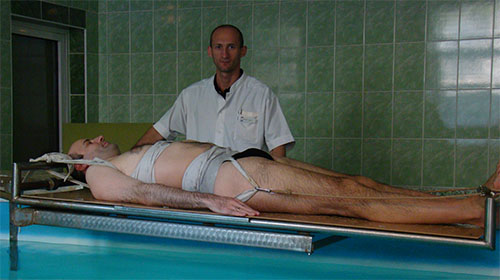
On the first day the extension is performed under its own weight, the following days are added by 1kg or 2kg, increasing to the fifth or seventh day, then decreasing the weights. Total 10-12 indicated procedures. If theres no improving after 7 procedures, the procedures are suspended. The indications of underwater extension suspention are: increased pain at the start and radieted to the leg. For total spine extension it is sufficient to apply 9kg weight. Applying more than 17-20kg, causes reflector paravertebral muscle spasm, which blocks the extension. For these reasons, we recommend performing the underwater extension using no more than 17kg.
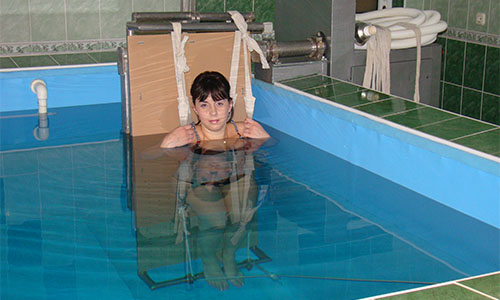
Underwater extension of the spine induce not only intradiscal pressure decrease, also acts on disc receptors, the ligaments, joints and paravertebral muscles, diminishing muscle hypertonus. Extension normalizes ratio between articular facets. After extension may decrease and disappear back pain, scoliosis and functional kyphosis. Underwater extension of the spine in spondylolisthesis is performed by Meyerding method, degree 2, in consultation with the orthopedic specialist, neurosurgeon. For leveling lordosis, the patient is in a position of flexion of the legs, by fixing the feet with a wide belt that is connected to the top bar of the table for extension.
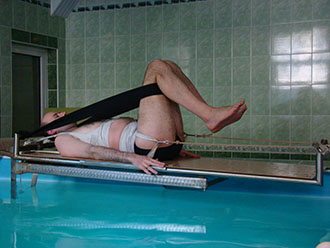
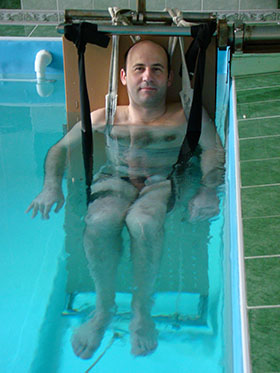
Recommendations
It is recommended after completion of the treatment:
- - Wearing Gessen type lumbostat for two weeks, but no more than 4 hours per day;
- - Refrain from smoking during treatment and recovery period;
- - Decrease body weight for obese people;
- - Correct weight lifting, keep your back straight;
- - Swimming in the recovery period and after, for building and maintaining muscle corset;
- - Back massage;
- - Individual physical daily therapy;